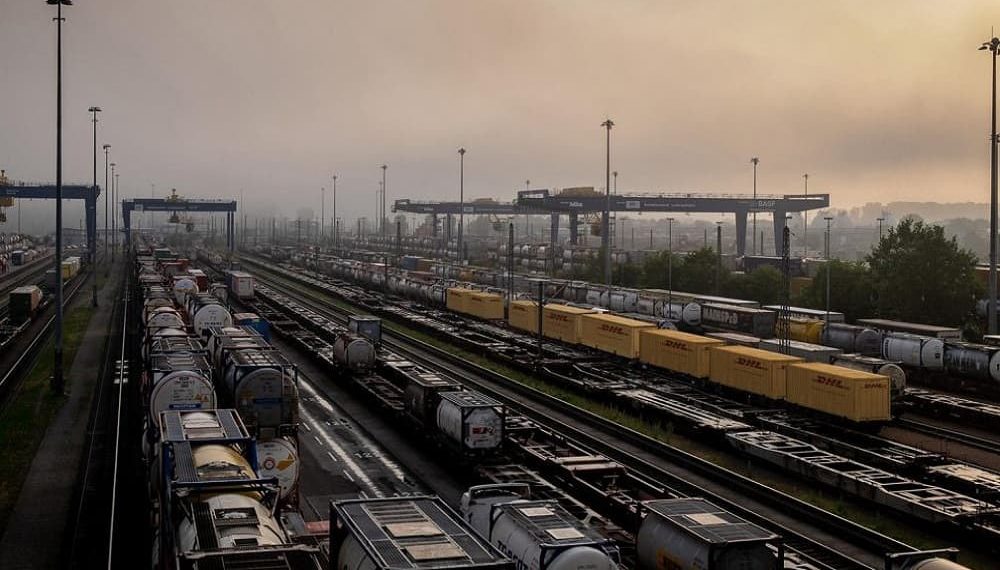Figures have shown that the UK rail freight network will play a vital role during Christmas 2020, with freight trains transporting more than 1.6 million tonnes of intermodal goods on almost 3,700 trains in November 2020 alone.
New figures have revealed that rail freight is set to play a key role in the run up to Christmas in 2020, delivering millions of tonnes of festive goods to shops around the country – almost a third of Tesco’s, the UK supermarket chain, Christmas range will reach their shelves by rail freight.
The supermarket giant is increasing the amount of goods that it transports by rail freight to boost reliability and reduce emissions to help tackle the climate emergency, and announced in September 2020 that it would be making a £5 million investment in their new rail freight equipment. In 2020, 30 per cent of Tesco‘s Christmas products will be transported by rail, representing a 70 per cent increase when compared to 2019.
Throughout the COVID-19 pandemic, the railway played a vital role in transporting key workers to where they were needed, with rail freight keeping supermarkets stocked and power stations fuelled as more people worked from home. Now that COVID-19 will mean a very different Christmas for many people across the country, rail companies are working hard to ensure that people have everything that they need for the holidays. In November 2020 alone, freight trains have transported more than 1.6 million tonnes of intermodal goods on almost 3,700 trains.
Director of Nations and Regions for the Rail Delivery Group (RDG), Robert Nisbet, said: “It’s been a challenging year for many people across Britain, so we’re happy that rail freight can play a central role in delivering Christmas cheer, ensuring that families have everything they need to celebrate in style. With only a fraction of the emissions compared to road haulage, every tree, pudding and toy transported by rail is helping to make this a green Christmas.”
The amount of intermodal freight transported by rail has increased since 2019 and by almost 20 per cent over the last decade, delivering significant benefits for the environment. Each freight train can carry as much as 76 heavy goods vehicles, with only a fraction of the emissions, meaning a modal shift from road haulage to rail will not only help to tackle the climate emergency, but can also help to cut traffic jams, too.
Chris Connelly, Managing Director for Direct Rail Services, who operate rail freight transportation for Tesco, said: “Every month, we transport around 12,000 containers of vital goods across the country to ensure that shelves are stocked and Christmas presents available. Using our state-of-the-art Class 88 locomotives, we can move huge loads over hundreds of miles and, when running on overhead electricity, with zero exhaust emissions, making it absolutely fantastic for the environment.”
The UK Rail Minster, Chris Heaton-Harris, whose constituency, Daventry, contains the international rail freight terminal DIRFT, said: “The sheer volume of festive goods that are currently being transported across the country daily is reflective of the crucial role that the rail freight industry plays at this time of year. Rail freight has been fundamental in ensuring that the country, and the economy, has kept moving through the pandemic, and I am thankful to everyone working so hard to keep Christmas on track.”
Britain’s new high-speed railway, HS2, is now under construction and, once complete, it will provide additional capacity on the existing network to grow the amount of goods transported by rail, alongside increasing local and regional passenger services. Building HS2 frees up a massive amount of space on the existing railway by placing fast inter-city passenger services on their own pair of tracks. Once HS2 is operating, trains on existing lines can run much closer together, meaning that there will be more paths available for rail freight operators.
Mark Thurston, HS2 Ltd’s CEO, said: “It is fantastic that more of what we eat, drink and gift each other at Christmas is now travelling by rail, removing lorries from our roads and reducing the amount of carbon emitted by transport. However, many of our major railway lines have already run out of room for more freight trains, so, if we want to grow the amount of goods that we move by rail, then we need to create more space for them.”
“As well as offering low carbon journeys to hundreds of thousands of people every day, HS2 will also take the pressure off of the existing network for more local, regional and freight services. By unlocking much-needed capacity across the country, we can continue to see more freight travelling by cleaner, greener rail, as each tonne of freight transported by rail reduces carbon emissions by 76 per cent compared to road,” he added.


































